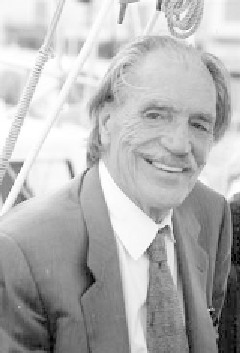Agriculture Reference
In-Depth Information
Figure 6.1
Ian McHarg.
Courtesy of Carol McHarg.
From the outset, we have argued that understanding the physical world depends
on a foundation in the laws of thermodynamics and motion. All engineering and
architectural curricula are built on this foundation. However, over the past few
decades, designs have become more adaptive. One noteworthy sea change was
the movement to “design with nature.” How important the preposition “with”
was to become to the design professions! The last three decades of the twentieth
century approached nature as a collaborator, not an opponent. In fact, in the
groundbreaking 1969 topic entitled
Design with Nature
,
2
IanMcHarg (see Fig. 6.1)
urged planners to conform to ecology rather than to compete with it. The topic,
which has sold more than 250,000 copies, has been likened to other influential
environmental works, including those by Lewis Mumford, Rachel Carson, even
going back to Henry David Thoreau.
Vallero recalls in the mid-1970s using the topic in his urban planning and
design graduate courses and being particularly struck by the profound yet simple
use of overlays (stacked Mylar maps). A transparency was prepared for each
attribute, such as wetlands, littoral vulnerability, urbanization, sensitive forests, or
water supplies. By overlaying different attributes (transparencies) atop each other,
patterns would become obvious, such as areas that needed special protection from
development. In fact, McHarg was a prominent critique of the close-mindedness
of many engineering project, such as highway planning (referring to the road
designers as “highwaymen”).
The elevated environmental consciousness that emerged from the upheavals
of the 1960s has led to many benefits. These are evidenced by the myriad
legislation, regulation, treaties, codes and ordinances that have given us a cleaner
world. However, one negative side effect is the growth of “junk science” in
environmentalism. Of course, not all environmentalism depends on weak and
unsound science, but too much is unsupported by the principles of physics,


Search WWH ::

Custom Search